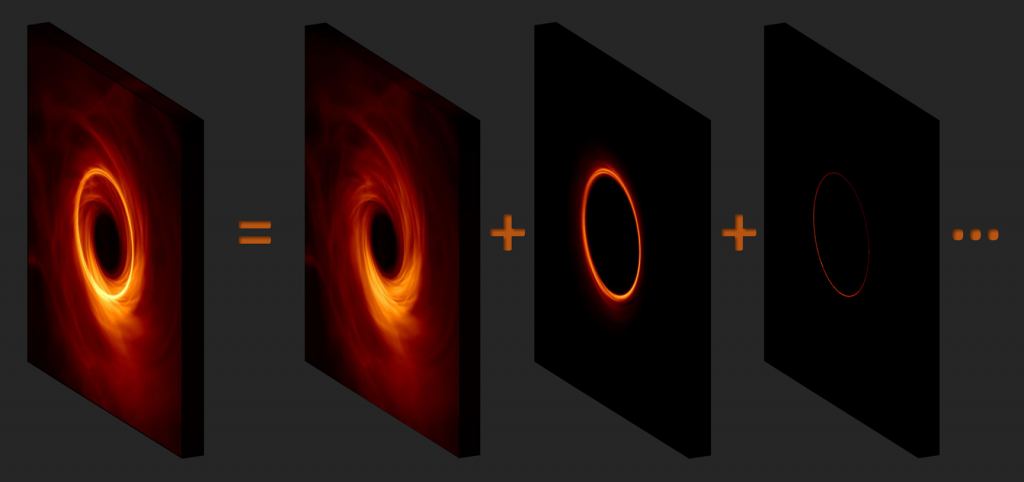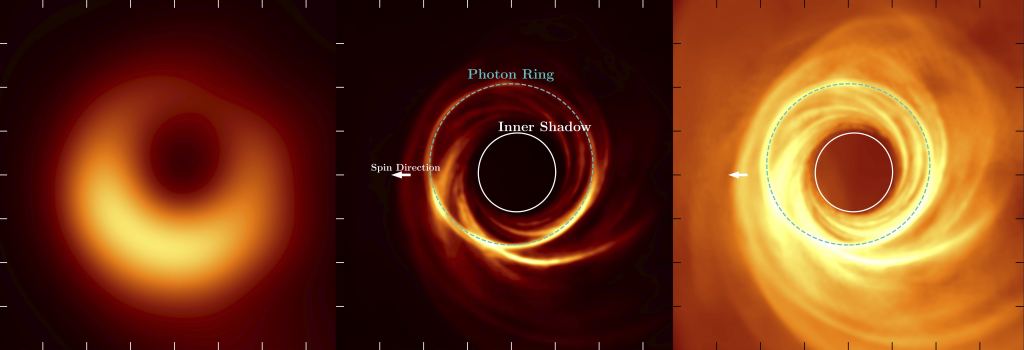Despite decades of study, black holes remain one of the most powerful and mysterious celestial objects ever studied. Because of the extreme gravitational forces involved, nothing can escape the surface of a black hole (including light). As a result, the study of these objects has traditionally been confined to observing their influence on objects and spacetime in their vicinity. It was not until 2019 that the first image of a black hole was captured by the Event Horizon Telescope (EHT).
This feat was made possible thanks to a technique known as Very-Long Baseline Interferometry (VLBI), which allowed scientists to see the bright ring surrounding the supermassive black hole (SMBH) at the center of the M87 galaxy. A new study by an international team of astronomers has shown how a space-based interferometry mission could provide reveal even more secrets hiding within the veil of a black hole’s event horizon!
The research was led by Leonid Gurvits, a researcher with the Joint Institute for Very Long Baseline Interferometry European Research Infrastructure Consortium (JIVE ERIC) and the Delft University of Technology. He was joined by researchers from the Institute of Radio Astronomy (INAF), the Netherlands Institute for Space Research (SRON), the Flatiron Institute’s Center for Computational Astrophysics, the Harvard-Smithsonian Center for Astrophysics (CfA), the Black Hole Initiative, and multiple universities and research institutes.
As they indicate in their study, ultra-high angular resolution in astronomy has always been seen as a gateway to major discoveries. In this process, known as interferometry, multiple observatories gather light from a single object that would otherwise be very difficult to resolve. In recent years, astronomers have relied on VLBI to detect radiation at the millimeter and submillimeter wavelengths. As study co-author Dr. Zsolt Paragi, a fellow researcher with JIVE ERIC, explained to Universe Today via email:
“In general, high angular resolution imaging is achieved in astronomy in three ways: by increasing the size of our telescopes, observing light at shorter wavelengths, and eliminating (or at least compensating for) the disturbances caused by the Earth’s atmosphere.
“Radio astronomy pioneered the development of imaging techniques based on interferometry, when the signal from different telescopes at large distances are seamlessly (in our terminology: coherently) combined. In this case, the ultimate factor that determines the resolving power of the instrument is the distance between the telescopes, which we call baselines.”
A good example of this is the Event Horizon Telescope (EHT), which captured the first image of a supermassive black hole (M87) on April 10th, 2019. This was followed in 2021 by an image of the core region of the Centaurus A galaxy and the radio jet emanating from it. However, these images were little more than faint circles, which represented the light trapped within the SMBHs’ event horizons – the boundary from which nothing (even light) can escape.
 Different photon paths create layers of light. Credit: George Wong (UIUC) and Michael Johnson (CfA)
Different photon paths create layers of light. Credit: George Wong (UIUC) and Michael Johnson (CfA)
Nevertheless, the image of M87 acquired by the EHT constituted the first direct confirmation of the existence of SMBHs and was the first time the shadows surrounding one were imaged. This image also provided a view of the infalling matter around the supermassive black hole, distorted by extremely strong gravity. In recent years, said Dr. Paragi, other developments have occurred in the field of VLBI that offer a taste of what’s to come:
“Another keystone result in recent years was proving the cosmological origin of the mysterious, millisecond-duration radio flashes we call fast radio bursts. Due to its excellent high-resolution imaging capability, the European VLBI Network provided by far the highest accuracy sky localization of these very brief signals, that are extremely difficult to catch even with the most modern interferometers.
“These centimeter-wavelength images not only show which galaxy the signals come from, but they can also narrow down the position of the signal to small regions within the galaxy which will be crucial for the understanding of the phenomenon.”
According to the astronomical community, the next logical step is to capture the Photon Ring. In this region, the gravitational force is so strong that photons are forced to travel in orbits. In the EHT images, much of the light from this ring was scattered before it reached Earth, creating the relatively blurred images that resulted. To build on their success, the next-generation EHT (ngEHT) will add ten new telescopes while modernizing those already part of the network.
 Simulation of the photon ring for M87*. Credit: Andrew Chael, et al
Simulation of the photon ring for M87*. Credit: Andrew Chael, et al
However, through space-based VLBI arrays, astronomers will be able to provide the most detailed images of the photon rings around SMBHs and even the event horizons themselves, according to Dr. Paragi. For the sake of their study, the team addressed the potential of a future VLBI space telescope known as the Terahertz Exploration and Zooming-in for Astrophysics (THEZA), which was the subject of a white paper by Gurvits, Paragi, and many of the team members who authored this latest paper.
This paper was submitted as part of the ESA Voyage 2050, an open call for large-class science mission proposals that will take place in the 2035-2050 timeline. Like space telescopes that study the cosmos in the optical, infrared, X-ray, radio and other parts of the spectrum, this concept calls for a space-based interferometer to study the physics of spacetime in the vicinity of SMBHs. As Dr. Paragi described it:
“Observing from space at very short, mm to sub-mm wavelengths will open new dimensions to VLBI. The advantages of a mission based on the THEZA concept are two-fold. On the one hand, being able to go below the wavelengths the Event Horizon Telescope [or the ngEHT], a new population of supermassive black holes would be accessible for resolved black hole shadow imaging, which is obscured for those instruments. In addition, it would allow unique probes of black hole spin and spacetime properties as well.”
Overall, the team reviewed all the telescope’s elements, including antenna systems, receivers, low-noise amplifiers, local oscillators, mixers, and data transport and processing. They found that an interferometer based on the THEZA concept would achieve the three main goals of an ultra-high angular resolution astronomy mission. In short, it will be free of interference from Earth’s atmosphere and observe black holes at higher frequencies and longer baselines than ever before.
 Illustration of the supermassive black hole at the center of the Milky Way. Credit: NRAO/AUI/NSF
Illustration of the supermassive black hole at the center of the Milky Way. Credit: NRAO/AUI/NSF
“By studying unique systems consisting of close pairs of supermassive black holes, THEZA may reveal processes that led to an accelerated black hole growth at the dawn of the Universe, which had a stark imprint on galaxy evolution as well,” added Dr. Paragi. “More importantly, THEZA will broaden our horizons for detailed black hole shadow measurement. This will result in a better understanding of gravity, which is important because gravity plays a fundamental role in shaping the Universe.”
In the coming years, next-generation observatories will rely on improved detectors and data transmission technologies to provide an even more detailed picture of some of the most mysterious objects in the Universe. These include proposals like the proposed Spektr-M space telescope, which is expected to launch by 2030. This instrument will be equipped with a 10 m (33 ft) primary mirror capable of observing the cosmos in the sub-millimeter to far-infrared wavelengths.
The James Webb Space Telescope (JWST), which reached its orbital destination (L2) in January and was almost cold enough (as of late April) to commence operations, will conduct its own interferometry studies soon. As part of the Near-Infrared Imager and Slitless Spectrograph (NIRISS) instrument, the Aperture Masking Interferometer (AMI) will turn the full aperture of JWST’s segmented mirrors into an interferometric array.
With NASA’s plans to send astronauts back to the Moon (as past of the Artemis Program) and other space agencies embarking on programs of lunar exploration, there are even proposals to build VLBI telescopes on the far side of the Moon – where they would be free of atmospheric or light interference. Without a doubt, the future of astronomy – like all of humanity’s greatest scientific undertakings – lies in space!
Further Reading: arXiv

